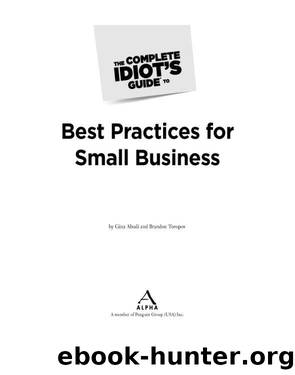The Complete Idiot's Guide to Best Practices for Small Business by Gina Abudi

Author:Gina Abudi
Language: eng
Format: epub
Publisher: Penguin Group USA, Inc.
Published: 2011-09-08T00:00:00+00:00
Determining Your Profitability
Conducting a break-even analysis assists you in determining how many sales you need to break even (no net loss or gain) and to begin to make a profit for your business.
DEFINITION
A break-even analysis is a technique used to analyze how much you need to generate in sales in order to achieve enough revenue to pay expenses and generate a profit.
By using a simple spreadsheet, you can determine how many sales you need to make of each product and service to offset your variable and fixed costs. This is your break-even point. Once you understand how many sales you need to make to cover all of your expenses, you can then determine how many additional sales are required to begin to make the desired profit for the business.
Letâs look at an example. Assume your break-even analysis shows that for you to cover your expenses you need to sell 25 widgets in a month. If you sell more, you begin to make a profit. You would like a profit of at least $5,000 each month to invest in research and development. To gain this much profit, you will need to sell 100 additional widgets each month. If you do not believe you will be able to sell 125 widgets in a month, you need to find other ways to make your profit of $5,000. This might include reducing your costs of producing widgets by negotiating with suppliers of your material or increasing the price of your widgets in the marketplace.
Determining your profitability requires you to have an understanding of two types of costs for your business: fixed costs (costs that remain the same no matter how much of a product you sell, such as costs for rent for your storefrontâthese costs must be covered even if you donât sell anything) and variable costs (costs that change depending on the number of products you sell, such as material costs or sales commissions).
Use this formula for your break-even analysis:Break-Even Point = Fixed Costs ÷ (Revenue Per Unit SoldâVariable Costs Per Unit)
Download
This site does not store any files on its server. We only index and link to content provided by other sites. Please contact the content providers to delete copyright contents if any and email us, we'll remove relevant links or contents immediately.
The ChatGPT Millionaire: Making Money Online has never been this EASY by Neil Dagger(740)
Dan Lok by unknow(657)
Side Hustles for Dummies by Simon Alan R.;(628)
Improving Internet Access to Help Small Business Compete in a Global Economy by Hermann E. Walker(534)
From Science to Business: Preparing Female Scientists and Engineers for Successful Transitions into Entrepreneurship: Summary of a Workshop by Catherine Jay Didion(499)
How to Grow Your Small Business by Donald Miller(486)
Start. Scale. Exit. Repeat. by Colin C. Campbell(485)
Tiny Business, Big Money by Elaine Pofeldt(443)
500 Ways to Make Money by NAVEEN CHAUHAN(441)
Founder vs Investor by Elizabeth Joy Zalman(426)
Do Bigger Things: A Practical Guide to Powerful Innovation in a Changing World by Wilde Jennifer & McClure Dan(404)
Think Your Way to Success: How to Develop a Winning Mindset and Achieve Amazing Results by Mark Rhodes(393)
The Startup Owner's Manual by Steve Blank(385)
The Worth of Water by Gary White & Matt Damon(375)
Read Books All Day and Get Paid For It: The Business of Book Coaching by Jennie Nash(373)
The Harder I Fall, the Higher I Bounce: Life Lessons From the Entrepreneur Dubbed the King of Kiosks by Fortune Magazine by Max James(372)
Studies on hydrolysisalcoholysisammonolysis mechanisms of ethylene terephthalate dimer using DFT method by unknow(372)
SURVIVAL SKILLS FOR FREELANCERS by Townsend Sarah(370)
The Five Most Important Questions You Will Ever Ask About Your Organization by Peter F. Drucker & NULL(368)
